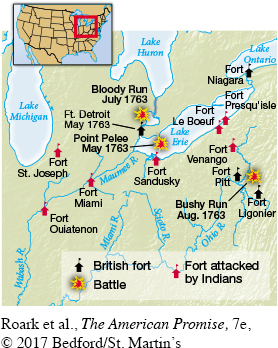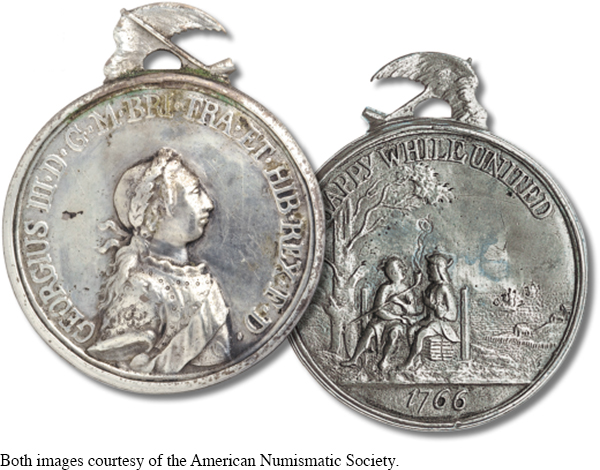The American Promise: Printed Page 143
The American Promise, Value Edition: Printed Page 132
The American Promise: A Concise History: Printed Page 150
Pontiac’s Rebellion and the Proclamation of 1763
One glaring omission marred the Treaty of Paris: The major powers at the treaty table failed to include or consult the Indians. Minavavana, an Ojibwa chief of the Great Lakes region, put it succinctly to an English trader: “Englishman, although you have conquered the French, you have not yet conquered us! We are not your slaves. These lakes, these woods and mountains were left to us by our ancestors . . . ; and we will part with them to none.” Furthermore, Minavavana pointedly noted, “your king has never sent us any presents, nor entered into any treaty with us, wherefore he and we are still at war.”
Minavavana’s complaint about the absence of British presents was significant. To Indians, gifts cemented social relationships, symbolizing honor and establishing obligation. Over many decades, the French had mastered the subtleties of gift exchange, distributing textiles and hats and receiving calumets (ceremonial pipes) in return. British military leaders, new to the practice, often discarded the calumets as trivial trinkets, thereby insulting the givers. From the British view, a generous gift might signify tribute (thus demeaning the giver), or it might be positioned as a bribe. “It is not my intention ever to attempt to gain the friendship of Indians by presents,” Major General Jeffery Amherst declared. The Indian view was the opposite: Generous givers expressed dominance and protection, not subordination, in the ceremonial practices of giving.
The American Promise: Printed Page 143
The American Promise, Value Edition: Printed Page 132
The American Promise: A Concise History: Printed Page 150
Page 144The Seven Years' War
| 1692– |
English and Iroquois create and affirm the Covenant Chain alliance in western New York. |
| 1700– |
French settlers enjoy exclusive trade with Indians in Ohio Valley. |
| 1747 | Ohio Company receives land grant from British king. |
| 1753 | Mohawk chief Hendrick accuses English of breaking Covenant Chain. |
| French soldiers advance from Canada into Ohio Country. | |
| George Washington delivers message telling French they are trespassing. | |
| 1754 | French build Fort Duquesne. |
| Washington returns to Ohio Country with troops and Mingo allies. | |
| May. Washington, guided by Mingo chief Tanaghrisson, attacks French. | |
| June– |
|
| July. French and Indian soldiers defeat Washington at Fort Necessity. | |
| 1755 | British authorities appoint two superintendents of Indian affairs. |
| July. Braddock defeated at Monongahela. | |
| 1756 | William Pitt becomes British prime minister. |
| 1758 | British capture Fort Duquesne. |
| 1759 | British capture Forts Niagara and Ticonderoga. |
| 1760 | British capture Montreal. |
| 1762 | British capture Cuba. |
| 1763 | Treaty of Paris signed. |
Despite Minavavana’s confident words, Indians north of the Ohio River had cause for concern. Old French trading posts all over the Northwest were beefed up by the British into military bases. Fort Duquesne, renamed Fort Pitt to honor the victorious leader, gained new walls sixty feet thick at their base, announcing that this was no fur trading post. Tensions between the British and the Indians in this area ran high.

A religious revival among the Indians magnified feelings of antagonism toward the British. In 1763, the renewal of commitment to Indian ways and the formation of tribal alliances led to open warfare, which the British called Pontiac’s Rebellion, named for the chief of the Ottawas. In mid-
Some Americans exacted revenge. The worst violent aggression occurred in late 1763, when some fifty Pennsylvania vigilantes known as the Paxton Boys descended on a peaceful village of friendly Conestoga Indians, murdering twenty. The vigilantes, now numbering five hundred, marched on Philadelphia to try to capture and murder some Christian Indians held in protective custody there. British troops prevented that, but the Paxton Boys escaped punishment for their murderous attack on the Conestoga village.
In early 1764, the uprising faded. The Indians were short on ammunition, and the British were tired and broke. The British government recalled the imperious general Amherst, blaming him for mishandling the conflict, and his own soldiers toasted his departure. A new military leader, Thomas Gage, took command and began distributing gifts profusely among the Indians.
To minimize violence, the British government issued the Proclamation of 1763, forbidding colonists to settle west of the Appalachian Mountains in order to protect Indian territory. But the Proclamation’s language also took care not to identify western lands as belonging to the Indians. Instead, it spoke of lands that “are reserved to [Indians], as their Hunting Grounds.”

Other parts of the Proclamation of 1763 referred to American and even French colonists in Canada as “our loving subjects,” entitled to English rights and privileges. In contrast, the Indians were rejected as British subjects and described more vaguely as “Tribes of Indians with whom We are connected.” Of course, the British were not really well connected with any Indians, nor did they wish connections to form among the tribes. As William Johnson, the superintendent of northern Indian affairs, advised in 1764, “It will be expedient to treat with each nation separately . . . for could they arrive at a perfect union, they must prove very dangerous Neighbours.”
The 1763 boundary was a further provocation to American settlers and also to land speculators who (like the men of the Ohio Company) had already staked claims to huge tracts of western lands in hopes of profitable resale. Yet the boundary proved impossible to enforce. Surging population growth had already sent many hundreds of settlers, many of them squatters, west of the Appalachians. Periodic bloodshed continued and left the settlers fearful, uncertain about their futures, and increasingly wary of British claims to be a protective mother country.
The American Promise: Printed Page 143
The American Promise, Value Edition: Printed Page 132
The American Promise: A Concise History: Printed Page 150
Page 145REVIEW How did the Seven Years’ War erode relations between colonists and British authorities?